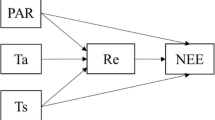Abstract
Principal component analysis (PCA) is commonly applied without looking at the “spatial support” (size and shape, of the samples and the field), and the cross-covariance structure of the explored attributes. This paper shows that PCA can depend on such spatial features. If the spatial random functions for attributes correspond to largely dissimilar variograms and cross-variograms, the scale effect will increase as well. On the other hand, under conditions of proportional shape of the variograms and cross-variograms (i.e., intrinsic coregionalization), no scale effect may occur. The theoretical analysis leads to eigenvalue and eigenvector functions of the size of the domain and sample supports. We termed this analysis “growing scale PCA,” where spatial (or time) scale refers to the size and shape of the domain and samples. An example of silt, sand, and clay attributes for a second-order stationary vector random function shows the correlation matrix asymptotically approaches constants at two or three times the largest range of the spherical variogram used in the nested model. This is contrary to the common belief that the correlation structure between attributes become constant at the range value. Results of growing scale PCA illustrate the rotation of the orthogonal space of the eigenvectors as the size of the domain grows. PCA results are strongly controlled by the multivariate matrix variogram model. This approach is useful for exploratory data analysis of spatially autocorrelated vector random functions.
Similar content being viewed by others
REFERENCES
Basilevsky, A., 1994, Statistical factor analysis and related methods, theory and applications: John Wiley & Sons, New York, 737 p.
Davis, B. M., and Greenes, K. A., 1983, Estimation using spatially distributed multivariate data. An example with coal quality: Math. Geology, v. 15, n. 2, p. 287–300.
Goovaerts, P., 1993, Spatial orthogonality of the principal components computed from coregionalized variables: Math. Geology, v. 25, no. 3, p. 281–301.
Goulard, M., and Voltz, M., 1992, Linear coregionalization: Tools for estimation and choice of cross-variogram matrix: Math. Geology, v. 24, no. 3, p. 269–286.
Journel, A. G., and Huijbregts, Ch. J., 1978, Mining geostatistics: Academic Press, New York, 600 p.
Mardia, K. V., Kent, J. T., and Bibby, J. M., 1979, Multivariate analysis: Academic Press, London, 521 p.
Myers, D. E., 1994, The linear model and simultaneous diagonalization of the variogram matrix function, in Fabbri, A. G., and Royer, J. J., eds., 3rd CODATA Conference on Geomathematics and Geostatistics: Sci. de la terre, Sér. Inf., Nancy, v. 32, p. 125–139.
Preisendorfer, R., 1988, Principal component analysis in meteorology and oceanography: Elsevier, New York, 425 p.
Sandjivy, L., 1984, The factorial kriging analysis of regionalized data. Its application to geochemical prospecting, in Verly, G., and others, eds., Geostatistics for Natural Resources Characterization: NATO-ASI Series C., v. 122, Reidel Publ. Co., Dordrecht, p. 559–572.
Vargas-Guzmán, J. A., Warrick, A. W., and Myers, D. E., 1999, Multivariate correlation in the framework of support and spatial scales of variability: Math. Geology, v. 31, no. 1, p. 85–103.
Wackernagel, H., 1985, The inference of the linear model of coregionalization in the case of a geochemical data set: Ecole des Mines de Paris, Centre de Geostatisque et de Morphologie Mathematique, Fontainebleau, 14 p.
Wackernagel, H., 1995, Multivariate geostatistics: Springer, Berlin, 256 p.
Warrick, A. W., Musil, S. A., Artiola, J. F., Hendricks, D. E., and Myers, D. E., 1990, Sampling strategies for hydrological properties and chemical constituents in the upper vadose zone, final technical report: University of Arizona, Tucson, Arizona, p. 117.
Xie, T., and Myers, D. E., 1995, Fitting matrix valued variogram models by simultaneous diagonalization. I Theory: Math. Geology, v. 27, no. 7, p. 867–876.
Author information
Authors and Affiliations
Rights and permissions
About this article
Cite this article
Vargas-Guzmán, J.A., Warrick, A.W. & Myers, D.E. Scale Effect on Principal Component Analysis for Vector Random Functions. Mathematical Geology 31, 701–722 (1999). https://doi.org/10.1023/A:1007532527596
Issue Date:
DOI: https://doi.org/10.1023/A:1007532527596




